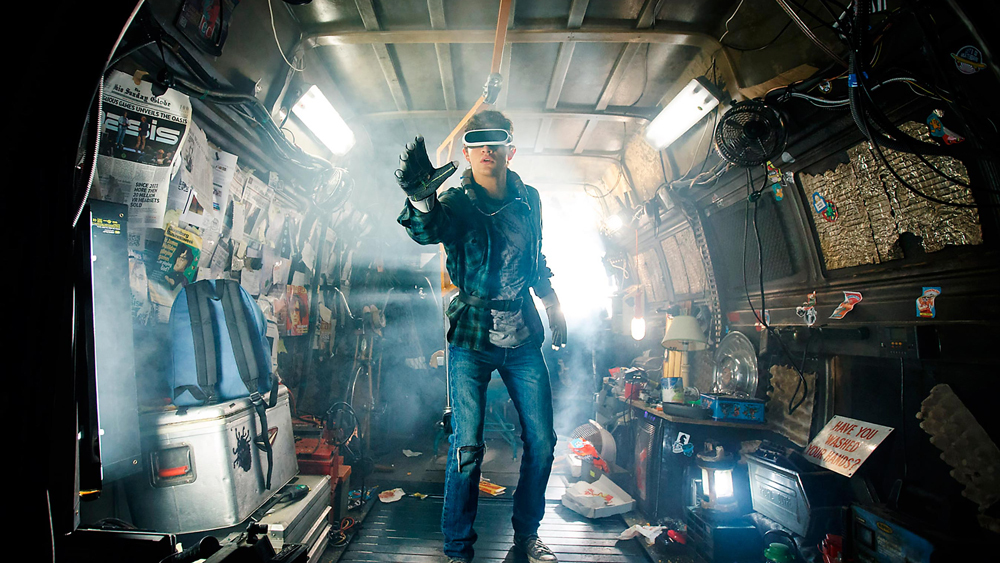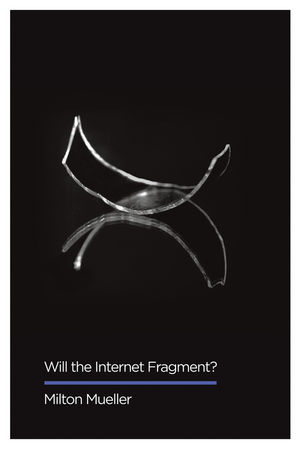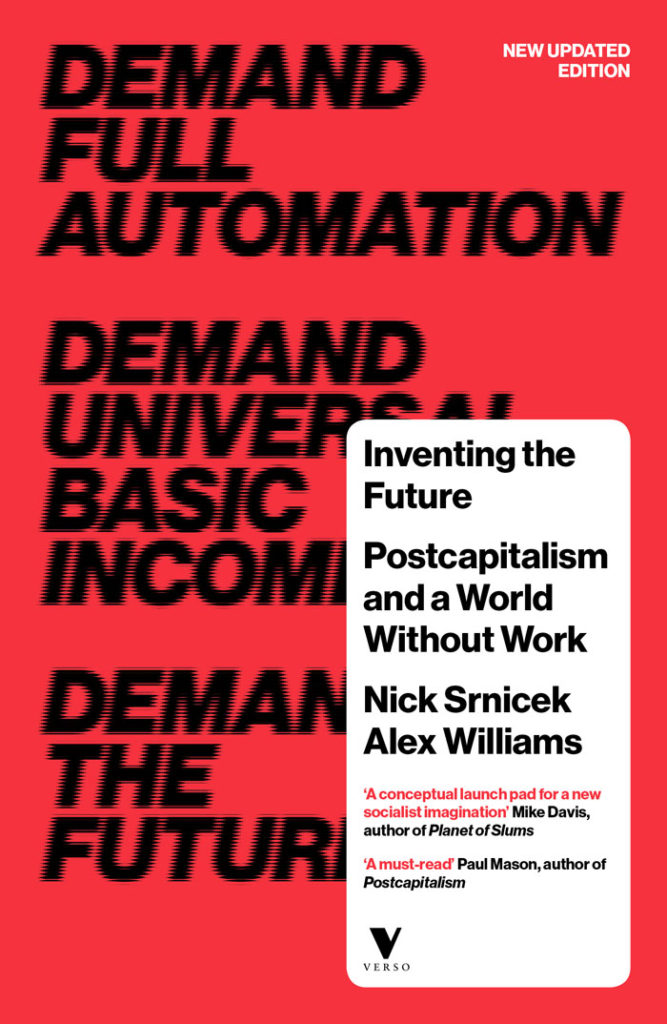by David Tomkins
I.
Ernest Cline’s bestselling novel Ready Player One (2011) envisions a future ravaged by war, climate change, famine, and disease in which most lived experience takes place in an immense multi-player virtual reality game called the OASIS. Created by James Halliday, an emotionally stunted recluse obsessed with 1980s pop culture, the OASIS promises relief from real world suffering by way of a computer-generated alternative reality overflowing with ‘80s pop culture references. Cline’s novel follows teenager Wade Watts on an adventure to locate the digital “Easter egg” that Halliday buried deep within the OASIS shortly before his death. Those seeking the egg must use three hidden keys (made of copper, jade, and crystal, respectively) to open secret gates wherein players face challenges ranging from expertly playing the arcade game Joust to flawlessly reenacting scenes from Monty Python and the Holy Grail. The first person to find the egg will inherit Halliday’s fortune, gain controlling stock in his company Gregarious Solutions, and assume control of Halliday’s virtual homage to the ‘80s, the OASIS.
Rich in the ‘80s nostalgia saturating popular entertainment in recent years, and with a particular reverence for Steven Spielberg’s ‘80s corpus, Cline’s novel attracted legions of readers upon publication and became an instant best seller.[1] The signing of Spielberg to direct and produce the film version of Ready Player One underscored the treatment of Spielberg’s films in the novel as quasi-sacred texts, and generated a kind of closed feedback loop between textual and visual object.[2] Shortly before the film went into production, Cline told Syfy.com that it was “still hard for [him] … to wrap [his] … head around Steven Spielberg directing this movie,” in part, because the director showed himself to be such a huge fan of Cline’s novel, arriving at pre-production meetings with a paperback copy of Ready Player One containing dozens of notes regarding moments he wanted to include in the film.[3]
But none of these moments, it turns out, included references to Spielberg’s earlier films. In fact, Spielberg made it a point to remove such references from the story. In 2016, Spielberg told Collider.com that he decided to make Ready Player One because it “brought [him] back to the ‘80s” and let him “do anything [he wanted] … except for with [his] own movies.”[4] “Except for the DeLorean and a couple of other things that I had something to do with,” [5] Spielberg added, “I cut a lot of my own references out [of the film].”[6] One can read Spielberg’s decision simply as an attempt to avoid self-flattery—a view Spielberg appears keen to popularize in interviews.[7] But equally compelling is the idea that Spielberg felt at odds with the version of himself celebrated in Cline’s novel, that of the marketable and broadly appealing director of block-busters like Jaws, E.T., and Raiders of the Lost Ark—in other words, the Spielberg of the ‘80s. Over the last twenty-five years, Spielberg has largely moved away from pulp genres toward a nominally more “serious,” socially conscious direction as a filmmaker (recent family-friendly films such as The BFG and The Adventures of Tintin notwithstanding). Ready Player One, however, a science fiction movie about teenage underdogs coming of age, sits comfortably among the films of Spielberg’s early canon—the deeply sentimental, widely appealing family-oriented films generally understood to have shaped the landscape of contemporary Hollywood.
The tension between early and late Spielberg in Ready Player One is among the driving forces shaping the director’s adaption of Cline’s novel. By removing most references to himself from the film, Spielberg not only rewrites an important aspect of the source material, he rewrites American cinematic history of the last 40 years. Jaws, Close Encounters, E.T., the Indiana Jones films—these works are in certain ways synonymous with ‘80s pop culture. And yet, in making a movie about ‘80s nostalgia, Spielberg begins by pointing this nostalgia away from its most famous and influential director. This self-effacing act, which effectively erases the Spielberg of the ‘80s from the film, and by extension from the era it commemorates, belies the humility animating Spielberg’s public comments on self-reference. Spielberg saturates Ready Player One—as Halliday does the OASIS—with a meticulously crafted self-image, and what’s more, affords himself total control over the medium wherein (and from which) that image is projected. Spielberg paradoxically rewrites popular memory as a reflection of his own preoccupations, making Ready Player One a film in which the future the audience is asked to escape into is defined by Spielberg’s rewriting of the cinematic past.
Central to Spielberg’s project of recasting ‘80s nostalgia in Ready Player One is an attempt to recuperate figures of corporate or governmental power—entities unlikely to have faired well in his ‘80s work. From the corrupt Mayor Vaughn in Jaws, to the pitiless government scientists in Close Encounters and E.T., to the bureaucrats who snatch Indy’s prize at the end of Raiders of the Lost Ark, figures in elite institutional positions typically pose a threat in early Spielberg. What’s more, in E.T., as well as Spielberg-produced films like The Goonies, these figures commit acts that compel young characters to take heroic, rebellious action. But in portraying Halliday as a meek, loveable nerd in Ready Player One, Spielberg introduces something new to the classic Spielbergian playbook that has implications not only for how we understand Spielberg’s ‘80s films, but also for how Ready Player One situates itself vis-à-vis contemporary pop culture. In Cline’s novel, Halliday comes across as a trickster figure in the mold of Willy Wonka—so much so that one of the first rumors to emerge about Spielberg’s adaptation of Ready Player One was that the director had coaxed Gene Wilder out of retirement to perform the role. Not only did that rumor turn out to be baseless, but the characterization of Halliday in Spielberg’s film neutralizes the faintly sinister underpinnings of Cline’s portrayal, replacing them with a goofy innocence, and an insistence—informed as much by contemporary celebrity worship as by Spielberg’s own status as an elder statesman of Hollywood—that the audience sympathize with, rather than despise, the all-powerful multi-billionaire.
Halliday’s vast corporate empire, his incalculable wealth, the extraordinary political and cultural power he undoubtedly wields as the creator of an entertainment technology juggernaut—none of these things factor into Spielberg’s portrayal. Rather, Spielberg’s film compels us to pity Halliday, to see him as someone who has suffered, someone whose genius has denied him the kind of emotional life that we, the audience, take for granted (or that Spielberg wants us to take for granted, as the rich emotional interiority he imagines is itself a construct). Given that both Halliday (in Cline’s novel and Spielberg’s film) and Spielberg (in the real world) share global renown as authors of popular entertainment, it’s unsurprising that Spielberg would sympathize with the character. After all, the name Spielberg, whether cited in a production or directorial capacity, or as a generic descriptor (“Spielbergian”), suggests “a mélange of mass appeal, sentiment and inchoate childlike wonder”—a description one could easily imagine applied to the OASIS.[8] But what is surprising is that Spielberg redeploys the sentimentality of his early work in Ready Player One to affirm the vertical social organization and imperialist ideology those films, at least on the surface, appear to attack.
The truth-to-power ethos of Spielberg’s ‘80s corpus is enlisted in Ready Player One to sentimentalize the corporate overlord’s yearning to protect his product and control his legacy. Similar to how the rebel struggle against the evil empire in George Lucas’s Star Wars films ultimately reinforces another corporate empire (Lucasfilm), Spielberg’s early rebellions—which were never all that “radical” to begin with, given Spielberg’s fondness for traditional hetero-normative social structures—fold in on themselves in Ready Player One, readjusted to serve the film’s confirmation of neoliberal ideology and corporate sovereignty. What looks superficially in Ready Player One like a toning down of Spielberg and a celebration of Cline is in fact Spielberg through and through, but with the ironic upshot being the recuperation of institutional and corporate power, the affirmation of existing class structures, and a recasting of the heroic rebellions one finds in Spielberg’s early work as far more conservative.
Unlike Spielberg’s film, Cline’s novel focuses a great deal on Halliday’s astonishing wealth, and it’s clear that for “gunters”—characters like Wade in search of Halliday’s egg—the acquisition of Halliday’s wealth is easily as important as gaining control of the OASIS. Wade, like most characters in Cline’s novel, is dirt poor: he, like millions of others, lives in a broken down mobile home stacked, along with dozens of others, hundreds of feet high. The world Cline describes is one of abject poverty: while the vast majority of people have next to nothing, Halliday, and a handful of corporate overlords like him, possess all the wealth, and wield all the power. This is not to overstate Cline’s interest in class in Ready Player One; indeed, he spends precious little time exploring the penurious world outside Halliday’s OASIS. Like his characters, it’s clear that Cline can’t wait to get back to the OASIS. But in Spielberg’s film, the at-best perfunctory acknowledgement of class dynamics seen in Cline’s novel is utterly ignored. Instead, Spielberg asks us to empathize with Halliday, maybe even to identify with him as much as—if not more than—we do with Wade.
Rather than encouraging us to revile the corporate overlord responsible for impoverishing the world and controlling the lives of the story’s youthful heroes, Ready Player One stands out among Spielberg’s oeuvre (and recent Hollywood films generally) for the way it recasts the “innocent” teenager Spielberg marketed so effectively as an implicit bulwark against oppressive powers in the ‘80s as a figure sympathetic to the dominant, unassailable corporate forces of the future.[9] Whereas in Cline’s novel Wade suggests using his newfound wealth to “feed everyone on the planet,” and to “make the world a better place,” Spielberg glosses over Wade’s windfall entirely, focusing instead on what Wade’s acquisition of the OASIS allows him to take away from—rather than give to—the powerless masses. In effect, the wayward teenagers of Spielberg’s corpus mature into a kind of “ghost in the machine” of capital.
The control Spielberg wishes to exert—over audiences, the film, the ‘80s—is perhaps most evident in the final moments of Ready Player One. As the film draws to a close, main character Wade speaks of disengaging from the OASIS to delight in the sensory and emotional experiences accessible only in the real world. In the novel, Cline similarly concludes with Wade revealing that “for the first time in as long as [he] could remember, [he] … had absolutely no desire to log back in to the OASIS”.[10] But in Spielberg’s hands, Wade’s newfound ambivalence about the OASIS has broader implications, as Wade, who ultimately wins control of the OASIS, sets limits on its availability, effectively forcing the tech-addled masses of 2045 to accept, as Wade now does, that “people need to spend more time in the real world.”[11]
However, the restrictions that Wade—and by extension Spielberg—puts in place fail to do this; rather, they reveal the film’s great irony: that Spielberg asks audiences to discover an empathetic, authentic reality in the context of a simulated world that he, Spielberg, creates (and, it is implied, that he alone could create). By adding to Wade’s character a strong inclination toward hetero-normative romantic connection in the real world, and by directing Wade to downgrade public access to the OASIS so that its millions of users may find “real” love, Spielberg invites his audience to seek out and prioritize “authentic” humanity in contrast to that offered in the OASIS. But Spielberg does so by positing as authentic a simulation of human connection, which he then presents as the corrective not only to the film’s characters’ obsession with technology, but also to that of contemporary western society. In doing so, Spielberg attempts to situate himself apart from peddlers of artificiality like Halliday (with whom he nevertheless clearly identifies). But instead he succeeds, despite his lifelong preoccupation with celebrating and stirring human connections and emotions, in becoming the master generator of simulacra. Ultimately the film’s viewers find themselves absorbed into the position of the creator of the OASIS, so that the absence of specific references to Spielberg’s early films conceals a remaking of the entire world of the film in Spielberg’s image.
II.
In the film’s final scene, Spielberg assembles numerous sentimental cues to soften Wade’s mandate that users henceforth limit their time in the OASIS, thus making his demands appear more altruistic than draconian. As the camera pans across what appears to be Wade’s spacious new apartment (a significant step up from the cramped trailer he lived in previously), we see Wade and his recently acquired girlfriend Samantha sharing a kiss as he explains in a voice-over his plans for the OASIS, and as the ‘80s pop of Hall and Oates’s “You Make My Dreams Come True” gradually dominates the soundtrack. While neither the voice-over nor the establishment of the romantic couple are particularly common tropes among Spielberg’s endings overall, the collision of familial sentimentality and budding romance we see in Ready Player One nevertheless recalls several of Spielberg’s endings from the late ‘70s and early ‘80s in films like Close Encounters, E.T., and Indiana Jones and the Temple of Doom.[12]
In anticipation of this highly sentimental ending, the film drastically accelerates the pace of the pair’s relationship: in the novel, they don’t meet in the real world until the last few pages, and their relationship—at least as far as Samantha is concerned—seems at best a work in progress. But Spielberg brings Wade and Samantha together in the real world halfway through the film, and makes their romantic connection a central concern. In doing so, and in explicitly depicting them in the final shot as a romantic couple, Spielberg creates contextual support for the argument he clearly wishes to make: that real world romance, rather than virtual game play, makes “dreams come true.” But even if this is so for Wade and Samantha, there’s little evidence to suggest that OASIS addicts around the world have had a similar experience. The suggestion, of course, is that they will—once they’re forced to.
Not only do Wade’s new rules for the OASIS disregard the social upheaval that the narrative all but ensures would take place, they also aggressively elide the anti-social foundation upon which the OASIS was conceived. In an earlier scene, Halliday reveals that he created “the OASIS, because [he] … never felt at home in the real world,” adding that he “just didn’t know how to connect with the people there.” Whether simulations of Atari 2600 games like Adventure or of movie characters like Freddie Kruger, the contents of the OASIS are not only replicas, they’re replicas of replicas—virtual manifestations of Halliday’s adolescent obsessions placed in a world of his own making, and for his own pleasure. One “wins” in the OASIS by collecting virtual inventories of Halliday’s replicas, and gains social significance—in and outside the OASIS—according to what (and how much) one has collected.
Despite cautioning Wade to avoid “getting lost” in the OASIS and revealing that, for him, the real world is “still the only place where you can get a decent meal,”[13] Halliday stops short of amending the central function of the OASIS as a replacement of, rather than supplement to, human interaction in the real world. Meanwhile, Wade’s parting words in the film limiting access to the OASIS point spectators toward an artificial reality of Spielberg’s making that is deeply invested in hiding its own artifice, and that punctuates a series of rewritings that remove Spielberg references from the film while simultaneously saturating it with his presence. At the same time, Spielberg ensures that the spectator’s sense of the ‘80s conforms to his own preoccupations, which themselves took hold in the context of the increasingly aggressive corporatization of the film industry that took place during this period. Consequently, the nostalgic universe generated in the film offers no exit from Spielberg, despite the absence of his name from the proceedings.
The film rehearses this paradox once again in its treatment of Halliday’s end, which differs significantly from that of the novel. Arguably Spielberg attempts to secure his controlling presence—both in the film, and of cinematic history—by leaving ambiguous the fate of the OASIS’s creator. Although in both the book and the movie Halliday’s avatar Anorak appears to congratulate Wade (known as Parzival in the OASIS) on acquiring the egg, Cline describes an elaborate transfer of powers the film all but ignores. Upon taking Anorak’s hand, Wade looks down at his own avatar to discover that he now wears Anorak’s “obsidian black robes” and, according to his virtual display, possesses “a list of spells, inherent powers, and magic items that seemed to scroll on forever.”[14] Halliday, now appearing as he often did in the real world with “worn jeans and a faded Space Invaders T-shirt” comments, “Your avatar is immortal and all-powerful.”[15] Moments later Cline writes:
Then Halliday began to disappear. He smiled and waved good-bye as his avatar slowly faded out of existence … Then he was completely gone.[16]
Under Spielberg’s direction, this scene—and in particular Halliday’s exit—play out very differently. While we are made aware of Wade’s victory, his avatar’s appearance remains unchanged and there’s no mention of Wade gaining all-powerful immortality. And whereas Cline explicitly refers to the image of Halliday that Wade encounters as an avatar—and therefore a program presumably set to appear for the benefit of game’s victor—the film goes out of its way to establish that this image of Halliday is nothing of the sort. When Wade asks if Halliday is truly dead, the image responds in the affirmative; when asked if he’s an avatar, the image replies no, and doesn’t respond at all to Wade’s final question, “what are you?” Instead Halliday’s image, accompanied by another image of his childhood self, walks silently through a doorway to an adjacent room and closes the door.
Rather than supplanting himself with a younger overlord and “fading out of existence” as he does in the novel, Spielberg’s Halliday remains part of the world he created, hesitant to relinquish full control. Closing the door behind him may signify an exit, but it doesn’t preclude the possibility of a return, especially given that neither he nor Wade locks the door. In place of closure, Halliday’s departure, along with his acknowledgement that he’s neither real nor simulation, suggests a more permanent arrangement whereby Halliday remains the animating essence within the OASIS. Halliday cannot “fade out of existence” in the OASIS because he effectively is the OASIS—its memory, its imagination, the means through which its simulations come to life. Whereas in the novel, Anorak’s transferal of power to Wade/Parzival suggests an acquisition of unadulterated control, the film proposes an alternative scenario in which Halliday’s creative powers are not fully transferable. In order for the OASIS to function, the film implies, Halliday must somehow remain within it as a kind of guiding force—a consciousness that animates the technological world Halliday created.
By replacing the simulation of Halliday that Wade encounters at the end of the novel with a mysterious deity figure taking up permanent residence inside the OASIS, Spielberg betrays a level of affection for the multi-billionaire world builder reminiscent of his treatment of the John Hammond character in Jurassic Park (1993). In that film, Spielberg spares the life of the deadly park’s obscenely wealthy creator and CEO—portrayed with jolly insouciance by Richard Attenborough—despite being ripped to pieces by dinosaurs in Michael Crichton’s novel of the same name. In Ready Player One Spielberg ups the ante, allowing the world builder and corporate overlord to ascend to godly status, therefore ensuring that while the OASIS exists, so will its creator Halliday.
III.
In contrast to the clear-cut usurpation of the eccentric billionaire by the indigent but tenderhearted teenager seen in Cline’s novel, the movie version of Ready Player One asks audiences to accept a more opaque distribution of controlling interests. While on the one hand the film presents the OASIS as a site of emotional suppression wherein users—following Halliday’s example—favor artificial stimulation over real world emotional connection, it also insists viewers recognize that Halliday created the OASIS in response to real world emotional trauma. The film uses this trauma to neutralize the class distinctions between Wade and Halliday that the novel highlights, and asks spectators to view both characters through a lens of universalized emotional vulnerability. The film then uses this conception of emotional trauma to encourage spectators to sympathize and identify with the corporate billionaire, welcome his transcendence into technological deification, and accept Wade not as a usurper but as an administrator of Halliday’s corporate vision.
But by magnifying the role social anxiety and fear of human intimacy played in creating the OASIS, the film also sets up the OASIS itself as, ultimately, a site of redemption rather than emotional suppression. Nowhere is this reworking of the OASIS more striking than during Wade’s attempt to complete Halliday’s second challenge. In a total overhaul of the novel, Wade (as Parzival) seeks clues unlocking the whereabouts of the Jade Key by visiting Halliday’s Journals, a virtual reference library located inside the OASIS. In the novel, gunters carefully study a digital text known as Anorak’s Almanac, an encyclopedia of ‘70s and ‘80s pop culture memorabilia compiled by Halliday and named after his avatar. The film replaces the almanac with a “physical” archive holding various pop culture artifacts of importance to Halliday, as well as memories of actual events in Halliday’s life. Crucially, like everything else in the OASIS, the contents of Halliday’s Journals are simulations created by Halliday based on his own memories.
These memories appear as images carefully re-imagined for cinematic display: gunters watch Halliday’s “memory movies” via a large rectangular screen through which (or on which) the images themselves appear (or are projected) as a kind of three-dimensional hologram. Looking at the screen is to look into the environment in which the events occurred, as if looking through a wall. In the memory containing Halliday’s one and only reference to Karen Underwood—his one-time date, and the future wife of his former business partner Ogden Morrow—Halliday approaches what is essentially the “fourth wall” and, while not necessarily “breaking” it, peers knowingly into the void, signaling to gunters—and thus to spectators—that recognizing the significance of this “leap not taken” regarding his unrealized affection for Karen is crucial to completing the second challenge. Spielberg latches on to Halliday’s failure with Karen, making this missed romantic opportunity the site of significant lifelong emotional trauma, and the de facto cause of Halliday’s retreat into creating and living in the OASIS.
Halliday’s archive also contains all of his favorite ‘80s movies, which appear as immersive environments that gunters may explore. Upon learning that Halliday, on his one and only date with Karen, took her to see Stanley Kubrick’s 1980 adaptation of Stephen King’s novel The Shining (1980), Wade (again, as Parzival) and his comrades (and the film’s audience) enter the lobby of the Overlook Hotel exactly as it appears in Kubrick’s film. The ensuing sequence is particularly revelatory in that we witness the camera gleefully roaming the interiors of Kubrick’s Overlook Hotel. Spielberg clearly delights in this scene, in the same way that Halliday, in Cline’s novel, relishes simulating the cinematic worlds of War Games and Monty Python and the Holy Grail. But in those cases, OASIS players must adopt one of the film’s characters as an avatar in order to show reverence by reciting dialogue and participating in scenes. In Cline’s novel, Halliday is interested in using reenactment to measure the depth of players’ devotion to Halliday’s favorite films.
In Spielberg’s adaptation, however, Parzival enters Halliday’s simulation of The Shining not as part of the story, but as a spectator. In one sense, Spielberg’s Halliday opens cinema up to players, enabling them to remain “themselves” while interacting with cinematic environments to discover clues leading to the jade key and therefore victory in Halliday’s second challenge. The theory of spectatorship that the film seems to advance during this sequence insists that the real pleasure of cinema lies not in the passive watching of it, but in its imaginative regeneration and exploration. The spectator’s imagination has the ability to call up a cinematic memory, and to stage one’s own stories or scenes in the environments recalled there. To connect with a film is to hold it in one’s memory in such a way that in can be explored repeatedly, and in different ways.
But while this conception of spectatorship appears to give viewers the ability to make cinema broadly their own, in fact, with Spielberg’s inhabiting of The Shining, we witness a specific transmutation of Kubrick’s text into an entry in Spielberg’s own corpus. In The Shining, Kubrick crushes those aspects of Stephen King’s narrative that would have importance for Spielberg, namely King’s interest in family trauma and intergenerational conflict. For Kubrick, the family is a scene of a pure violence that infects and corrodes the human capacity for empathy and rationality, thereby forcing violent action recursively back on itself. Kubrick’s film is clearly anti-Spielbergian in this sense, and yet in his replay of The Shining in Ready Player One, Spielberg does his own violence to Kubrick’s vision, taking control of the simulacrum and re-producing The Shining as a site of redemption, whereas in Kubrick it’s certainly not.
After a series of gags that play some of Kubrick’s most haunting images—the twin sisters, the torrent of blood, the decaying women in room 237—for laughs, Wade finds himself in the ballroom of the hotel. Once there, the simulation of Kubrick’s film gives way to a new setting completely unique to Halliday’s imagination, wherein dozens of decomposing zombies dance in pairs, with a simulation of Halliday’s never-to-be love, Karen Underwood, being passed from zombie to zombie. To win the challenge, a player must figuratively make the “leap” that confounded Halliday, using small, suspended platforms, as well as zombie shoulders and heads, to make his way to Karen, whom he must then ask to dance. This challenge reveals to players, and to the audience, Halliday’s emotional vulnerability, highlighting his regret, and foreshadowing the lesson Spielberg imposes on viewers at the film’s end: namely, that audiences should see Halliday’s story as a cautionary tale warning against using technology to repress the need to connect with other human beings.
Spielberg begins his adaption of Cline’s novel with another radical revision, substituting an action set piece—a car race—for an elaborate two-tier challenge wherein Wade must best a Dungeons and Dragons character playing the classic arcade game Joust and later recite dialogue from the ‘80s movie War Games starring Mathew Broderick. After several failed attempts, Wade discovers that in order to win the race he must travel backwards, a move clearly highlighting the film’s nostalgic turn to the ‘80s. Although this sequence features the film’s most overt reference to Spielberg’s ‘80s corpus in the form of Wade’s car, a replica of Marty McFly’s DeLorean from the Spielberg-produced film Back to the Future, more significant is the extremity of the challenge’s revision, and the fact that nothing within the film or Cline’s novel suggests that a big action spectacle with lots of fast cars might be at all in keeping with Halliday’s ‘80s pop culture preoccupations.
More likely, given the affinity Spielberg shows throughout the film for redressing Halliday’s world in his own image, is that this sequence pays homage to Spielberg’s friend (and fellow Hollywood elder) George Lucas, whose own early corpus was defined, in part, not only by his film American Graffiti, but by his trademark directorial note, “faster and more intense”—a note this sequence in Ready Player One takes to heart. With this scene and the others mentioned previously, Ready Player One recasts “classic Spielberg” by shifting emphasis away from teenage innocents and toward corporate overlords with whom the story’s young heroes are complicit in the project of subjugation. What emerges is the supremacy and permanence of the corporate overlord whom Spielberg both identifies with and wishes to remake in his own image in such a way that the overlord’s world becomes a site for the Spielbergian values of homecoming and redemption rather than emotional repression aided by escape into simulacra. The irony being that the world of homecoming and redemption he offers is itself nothing other than cinema’s simulation.
Bibliography
Breznican, Anthony. “Steven Spielberg Vowed to Leave His Own Movies Out of ‘Ready Player One’—His Crew Vowed Otherwise.” Ew.com, March 22, 2018, http://ew.com/movies/2018/03/22/ready-player-one-steven-spielberg-references/.
Cabin, Chris. “’Ready Player One’: Steven Spielberg Says He’s Avoiding References to His Own Movies.” Collider.com, June 22, 2016, http://collider.com/ready-player-one-steven-spielberg-easter-eggs/.
Cline, Ernest. Ready Player One. Broadway Books: New York, 2011.
Hunter, I.Q. “Spielberg and Adaptation.” A Companion to Steven Spielberg. Ed. Nigel Morris. Wiley Blackwell: West Sussex, 2017. 212-226.
Kramer, Peter. “Spielberg and Kubrick.” A Companion to Steven Spielberg. Ed. Nigel Morris. Wiley Blackwell: West Sussex, 2017. 195-211.
Nealon, Jeffrey T. Post-Postmodernism or, The Cultural Logic of Just-in-Time Capitalism. Stanford, CA: Stanford UP, 2012.
Russell, James. “Producing the Spielberg ‘Brand.’” A Companion to Steven Spielberg. Ed. Nigel Morris. Wiley Blackwell: West Sussex, 2017. 45-57.
Spielberg, Steven, Dir. Ready Player One. 2018.
Walker, Michael. “Steven Spielberg and the Rhetoric of an Ending.” A Companion to Steven Spielberg. Ed. Nigel Morris. Wiley Blackwell: West Sussex, 2017. 137-158.
Watkins, Denny. “Ernest Cline Geeks Out About Spielberg Adapting ‘Ready Player One.’” Syfy.com, May 2, 2016, http://www.syfy.com/syfywire/ernest-cline-geeks-out-about-spielberg-adapting-ready-player-one.
Vinyard, Papa, “Be Ready for ‘Ready Player One’ in December 2017.” Ain’t it Cool News, August 6, 2015, http://www.aintitcool.com/node/72613.
Notes
[1] From remakes (The Karate Kid, Clash of the Titans) and sequels (Tron: Legacy, Wall Street: Money Never Sleeps) to original TV shows drawing on ‘80s cultural influences (Stranger Things, The Americans), ‘80s nostalgia has been exceedingly popular for the better part of a decade. Addressing the current ubiquity of the ‘80s, Jeffery T. Nealon argues that “it’s not so much that the ‘80s are back culturally, but that they never went anywhere economically,” adding, “the economic truisms of the ‘80s remain a kind of sound track for today, the relentless beat playing behind the eye candy of our new corporate world” (Post-Postmodernism).
[2] When it was announced that Spielberg would adapt Ready Player One, entertainment journalists rejoiced, describing the move as a “return to ‘blockbuster filmmaking’” for Spielberg that would give Cline’s story both “street cred and … mainstream appeal” (Vinyard, “Be Ready for ‘Ready Player One’”).
[3] Watkins, “Ernest Cline Geeks Out”
[4] Cabin, “‘Steven Spielberg Says”
[5] In both the novel and film, Wade’s avatar, known as Parzival in the OASIS, drives a simulation of the DeLorean featured in the Back to the Future films, which Spielberg produced.
[6] Cabin, “Steven Spielberg Says”
[7] Spielberg remarked in 2016 that, “[he] was very happy to see there was enough without [him] that made the ‘80s a great time to grow up” (Cabin, “Spielberg Says”), and in a 2018 interview with Ew.com Spielberg insisted, “I didn’t corner the ‘80s market … there’s plenty to go around” (Breznican, “Steven Spielberg Vowed”).
[8] Russell, “Producing the Spielberg ‘Brand.’”
[9] While it’s true, in both the novel and the film, that prohibiting corporatist Nolan Sorrento from acquiring the OASIS is a priority for Wade, what motivates him is not antipathy to capitalist enterprise, but rather the desire to preserve the “pure” capitalist vision of the OASIS’s corporate creator, Halliday. Averse to Sorrento’s plans to further monetize the OASIS by opening up the platform to infinite numbers of advertisers, Wade simply prefers Halliday’s more controlled brand of corporatism, which appears rooted in what Nealon would describe as “the dictates of ‘80s management theory (individualism, excellence, downsizing)” (5, Post-Postmodernism). The film likewise shares an affinity for heavily centralized, individualized, and downsized corporate control.
[10] Cline, Ready Player One, 372.
[11] Spielberg, Ready Player One.
[12] Walker, “Rhetoric of an Ending,” 144-145, 149-150.
[13] Spielberg, Ready Player One
[14] Cline, Ready Player One, 363.
[15] Cline, Ready Player One, 363.
[16] Cline, Ready Player One, 364.









 It is telling that, in Will the Internet Fragment?, Mueller starts his account with the 2014
It is telling that, in Will the Internet Fragment?, Mueller starts his account with the 2014 



